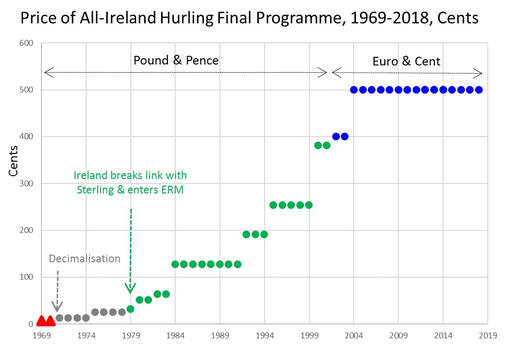The booklet has cost €5 (or 500 cents) for the last fifteen years. Prior to the move to the Euro, the purchaser handed over pounds and pence. This was the case for all of the 20th century years in the picture. In the majority of those years there were 100 pennies in a pound. However, this was not the case at the start of the period. Those two red triangles are from a period where there was 240 pennies in a pound. For those two years, the programme cost 1 shilling (or 12 pence).
During the 1970s and early 1980s Ireland experienced high rates of inflation. Programme price changes were no exception. In the period to 1984 there were three 100% increases, one 60% increase, and two 25% increases in programme prices. In later years the price has changes by 50% on two occasions.
It would be fair to say that income changes also influenced the amount of money handed over for the programme. It is no surprise that there was no change in the price during the decade since 2007.
Rather than annual change in prices there are a series of step changes. The size of the price changes make sense in terms of the way the transaction takes place. The majority of vendors stand close to the points where people enter the ground. To facilitate the transaction, it is useful if the price is readily made up of easily handled units of currency. Exchanging a €5 note for the programme is a neat transaction. The next increase will probably take the price to €6 or €7.

 RSS Feed
RSS Feed